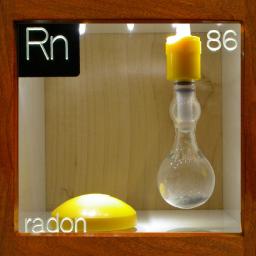Home Size: 1 2 3 4 5 6 7 8 9
|
 |
| A radioactive noble gas which forms as a transient decay product in Th and U ores, from which it escapes to present a danger in mines and cellars.
|
|
|
 |
Flask containing thorium oxide.
The white powder in the flask is the ash produced by burning one of the gas mantles displayed in the thorium cube. It is composed of almost pure thorium oxide. As the thorium slowly decays (it has a long half life of 13 billion years) its atoms undergo a complex series of transmutations, eventually ending up as stable Pb-208 which is the commonest isotope in natural lead. Along the way, the decayed thorium atoms briefly exist as Rn-220 which has a half life of just under one minute. At any given time, there will be very approximately 100,000 atoms of radon gas inside the vessel.
Source: specially constructed
Size: flask 4"
Purity: n/a
|
|
 |
Radon detector.
Strictly speaking this yellow object does not contain any radon. Instead it is designed to detect the radioactive gas by absorbing it on activated charcoal. This is a monitoring device issued by the National Radiological Protection Board in the UK to people who live in houses built in parts of the country where the ground contains high levels of thorium and uranium ores. If cellars are not properly ventilated, potentially hazardous concentrations of radon gas can build up. Because radon is an unreactive noble gas, it is hard to filter. A single atom typically has a half-life of a few minutes or days and can easily be breathed in only to decay in the lungs to another radioactive element such as polonium. This element is a not volatile and so will stick to the cells, remaining in the body permanently and presenting a significant cancer hazard.
Source: kindly donated by the NRPB
Size: 3"
Purity: n/a
|
|
|

